|
|
| Resource |
Description |
ClinicalKey
via the Skelton Medical Libraries
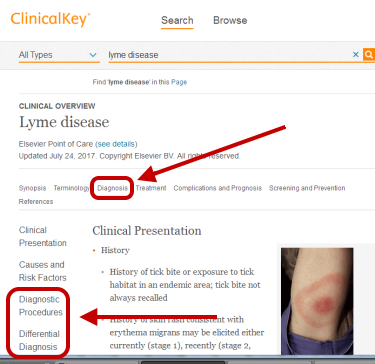 |
| You can add the term diagnostics to your
search. Or, after searching for a disease or condition, you can click on the
Clinical Overview link and select Diagnosis. |
|
ClinicalKey is a clinical search engine that supports clinical
decisions by making it easier to find and apply relevant knowledge. Also, there
is an app for this.
1. Follow this
ClinicalKey
link and click on "Register" in the top right hand corner.
2. Complete the
registration form.
3. On your mobile device, download the ClinicalKey app
and log in with your ClinicalKey username and password that you created when
you registered.
Once you are registered, you can access ClinicalKey from
anywhere with the username and password you created. You will need to register
to download pdfs and to save images. |
Diagnosaurus via the Skelton Medical Libraries
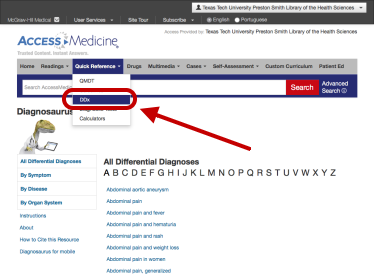 |
| From the
AccessMedicine
menu bar located above the search box, click on Quick Reference and then select
DDx |
|
Through Access Medicine, Diagnosaurus is a differential diagnosis
tool searchable alphabetically, by symptom, disease, and organ system. It is
available as a mobile app through the Access Medicine app.
For access
from anywhere and via mobile device, create an account by following this
AccessMedicine
link to their website.
1. Click the down arrow next to the Mercer
University box in the right hand upper corner.
2. Then "Login or Create a
Free Personal Account"
3. A popup window will appear. Select "Don't have a
MyAccess account?" and fill in the requested information and select "Create
Account"
4. On your mobile device go to the App/Google Play store and
download AccessMedicine. Log in and content should download.
5. Watch a
video for directions at: https://www.youtube.com/watch?v=eYb8Su6VT1o |
Ferri's
Differential Diagnosis: A Practical Guide to the Differential Diagnosis of
Symptoms, Signs, and Clinical Disorders, 2nd edition via the Skelton Medical Libraries
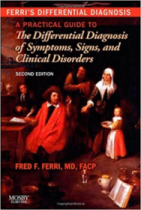 |
This book is a quick reference to the differential diagnosis, etiology, and
classification of clinical disorders, signs, and symptoms. The author presents
over 1000 signs, symptoms, and clinical disorders. |
Symptom
to Diagnosis: An Evidence-Based Guide, 3rd edition via the Skelton Medical Libraries
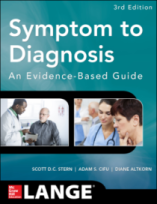 |
Each chapter in this book addresses one common complaint and begins
with a case and guidance on how to organize the differential diagnosis. As the
case progresses, clinical reasoning is explained in detail. The differential
diagnosis for that particular case is summarized in tables that highlight the
clinical clues and important tests for the leading diagnostic hypothesis and
alternative diagnostic hypotheses. As the chapter progresses, the pertinent
diseases are reviewed. Just as in real life, the case unfolds in a stepwise
fashion as tests are performed and diagnoses are confirmed or refuted. |
VisualDX
via the Skelton Medical Libraries
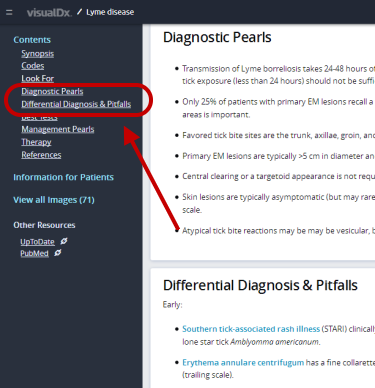 |
| After Searching for a disease or condition,
click on Diagnostic Pearls or Differential Diagnosis & Pitfalls |
|
VisualDX is a clinical decision support tool designed to help with
diagnosing of dermatological, infection, genetic, metabolic, nutritional and
occupational diseases. The resource includes more than 140,000 images of
visually identifiable diseases, drug reactions, and infections. Basic
descriptions of different diagnosis and direct links to UpToDate and PubMed,
provides the users with clinical background and support information. A mobile
app is available for easy access to VisualDX at the point of care
Mobile
Access:
1. Follow this
VisualDX
link and click “Get the Mobile App" (center of VisualDx homepage).
2.
Create your personal username and password as instructed. You will receive an
email from Logical Images.
3. Once you have a username and password, you
can download the free VisualDx Mobile app on your mobile device from the iTunes
Store or from Google Play.
4. Launch the VisualDx app from your device and
sign in using the username and password you created.
|
| Learn how to build a differential diagnosis
in VisualDx for fast, accurate answers at the point of care. |
|
|
|



